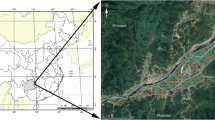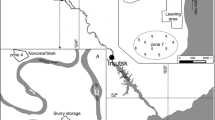Summary
Rice soils with different cropping age ranging from 0 to 600 years on Saga polder lands have been sampled and the total mercury has been determined with a high sensitivity mercury analyzer. Organomercurial application had the effect of raising soil mercury levels above the natural background. The mercury was generally confined to the surface soils where the content varied from 333 ppb to 86 ppb with an average of 214 ppb. The mercury content diminished quickly with depth, whereas the trend was less marked with decreasing cropping age (the younger soils). The natural background level of the soils in this area is approximately 79 ppb. Industrial and sewage outfalls from another area may be a significant factor with regard to the establishment of an elevated mercury level in the sediments available as a foundation material for future poldering works.
Plant analysis indicates that the rice takes up small amounts of mercury regardless of the concentration in the soil. The average mercury content of unhulled rice was 11 ppb and of straw 31 ppb, suggestive of its minor role in the food chain. Calculation showed that crop removal is a fruitless source of the mercury decline in the soil.
The discussion of mercury behavior in soil including the fate of applied PMA suggests that mercuric sulfide formation is probably more important than other factors in regulating mercury retention in rice soils. re]19751027
Similar content being viewed by others
References
Ando A., Kurasawa H., Ohmori T. and Takeda E., Compilation of data on the GSJ geochemical reference samples JG-1 granodiorite and JB-1 basalt. Geochem. J. 8, 175–192 (1974).
Aomine S., Kawasaki H. and Inoue K., Retention of mercury by soils. 1. Mercury residues of paddy and orchard soils. Soil Sci. Plant Nutr. Tokyo 13, 186–188 (1967).
Aomine S. and Inoue K., Retention of mercury by soils. 2. Adsorption of phenylmercuric acetate by soil colloids. Soil Sci. Plant Nutr. Tokyo 13, 195–200 (1967).
Applequist M. D., Katz A. and Turekian K. K., Distribution of mercury in the sediments of New Haven (Conn.) Harbor. Environ. Sci. Technol. 6, 1123–1124 (1972).
Engler R. M. and Patrick Jr.W. H., Stability of sulfides of manganese, iron, zinc, copper, and mercury in flooded and nonflooded soil. Soil Sci. 119, 217–221 (1975).
Furukawa K., Suzuki T. and Tonomura K., Decomposition of organic mercurial compounds by mercury-resistant bacteria. Agric. Biol. Chem. 33, 128–130 (1969).
Furutani T. and Osajima Y., Study on residual components from agricultural chemicals in food. 2. Value of mercury in rice. Sci. Bull. Faculty Agric., Kyushu Univ. 21, 371–376 (1965).
Furutani T. and Osajima Y., Study on residual components from agricultural chemicals in food. 3. Value of mercury in wheat, some vegetables and paddy field soil. Sci. Bull. Faculty Agric., Kyushu Univ. 22, 45–48 (1965).
Hahne H. C. H. and Kroontje W., The simultaneous effects of pH and chloride concentrations upon mercury (II) as a pollutant. Soil Sci. Soc. Am. Proc. 37, 838–843 (1973).
Hem, J. D., Chemical behavior of mercury in aqueous media. In Mercury in the environment. U. S. Geol. Surv. Prof. Pap. 713, 19–24 (1970).
Jonasson I. R., Mercury in the natural environment: a review of recent work. Geol. Surv. Can. Pap. 70–57, 1–39 (1970).
Jonasson I. R. and Boyle R. W., Geochemistry of mercury and origins of natural contamination of the environment. Can. Inst. Mining Met. Bull. 65, 32–39 (1972).
Jones R. L. and Hinesly T. D., Total mercury content in Morrow plot soils over a period of 63 years. Soil Sci. Soc. Am. Proc. 36, 921–923 (1972).
Kanazawa J. and Sato R., Determination of residual mercury in rice grains. Pages 17–25 In Residue analysis of organo-mercuric fungicides sprayed on rice and fruits. Japan Plant Protection Association, Tokyo (1965).
Kanno I., A new classification system of rice soils in Japan. Trans. Joint Meeting, Comm. 4 and 5, 617–624. Int. Soc. Soil Sci., New Zealand (1962).
Kanno I., Honjo Y., Arimura S. and Tokudome S., Genesis and characteristics of rice soils developed on polder lands of the Shiroishi area, Kyushu. Soil Sci. Plant Nutr. Tokyo 10, 1–19 (1964).
Kimura Y. and Miller V. L., The degradation of organomercury fungicides in soil. J. Agric. Food Chem. 12, 253–257 (1964).
Klein D. H. and Goldberg E. D., Mercury in the marine environment. Environ. Sci. Technol. 4, 765–768 (1970).
Kushizaki M., Results of examination on present situation of total mercury contents in rice grains by means of high sensitivity mercury analyzer (Shimadzu UV-201). J. Sci. Soil Manure, Japan 45, 536–538 (1974).
Lagerwerff J. V., Lead, mercury and cadmium as environmental contaminants. Pages 593–636 In J. J.Mortvedt, P. M.Giordano and W. L.Lindsay (ed.) Micronutrients in agriculture. Soil Sci. Soc. Am., Madison, Wisconsin (1972).
Matsuo H., Gotoh S., Sakurai T., Sato Y. and Inoko A., Soil development of Saga polder with special reference to changes of cation status in soils. Bull. Kyushu Agric. Expt. Sta. 7, 307–324 (1962).
Nose K. and Suzuki T., Fate of phenylmercuric acetate in waterlogged soil. Nogyo-seisan-gijutsu no. 17, 29–30 (1967).
Poelstra P., Frissel M. J., van derKlugt N. and Bannink D. W., Accumulation and distribution of mercury in Dutch soils. Neth. J. Agric. Sci. 21, 77–84 (1973).
Shacklette H. T., Boerngen J. G. and Turner R. L., Mercury in the environment-surficial materials of the conterminous United States. U. S. Geol. Surv. Circ. 644, 1–5 (1971).
Smart N. A., Use and residues of mercury compounds in agriculture. Residue Rev. 23, 1–36 (1968).
Takeuchi T., Distribution of mercury in the environment of Minamata Bay and the inland Ariake Sea. Pages 79–81 In R.Hartung and B. D.Dinman (ed.) Environmental mercury contamination. Ann Arbor Science Publishers Inc., Michigan (1972).
Tomizawa C., Mercury pollution by agricultural chemicals. Food Science 18, 39–45. Marunouchi Shuppan, Tokyo (1974).
Trost P. B. and Bisque R. E., Distribution of mercury in residual soils. Pages 178–196 In R.Hartung and B. D.Dinman (ed.) Environmental mercury contamination. Ann Arbor Science Publishers Inc., Michigan (1972).
van Faassen H. G., Effects of mercury compounds on soil microbes. Plant and Soil 38, 485–487 (1973).
Warren H. V., Delavault R. E. and Barakso J., Some observations on the geochemistry of mercury as applied to prospecting. Econ. Geol. 61, 1010–1028 (1966).
Author information
Authors and Affiliations
Rights and permissions
About this article
Cite this article
Gotoh, S., Koga, H. Mercury in rice soils developed on Saga polder lands, Northern Kyushu, Japan. Plant Soil 47, 49–61 (1977). https://doi.org/10.1007/BF00010367
Received:
Issue Date:
DOI: https://doi.org/10.1007/BF00010367




